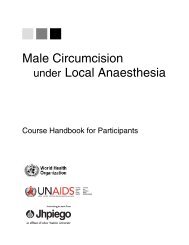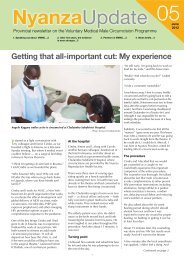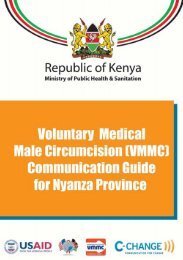Manual for Male Circumcision under Local Anaesthesia
Manual for Male Circumcision under Local Anaesthesia
Manual for Male Circumcision under Local Anaesthesia
You also want an ePaper? Increase the reach of your titles
YUMPU automatically turns print PDFs into web optimized ePapers that Google loves.
<strong>Male</strong> circumcision <strong>under</strong> local anaesthesia Version 2.5C (Jan08)<br />
• Infection with the yeast Candida albicans can result in an itchy,<br />
spotty rash.<br />
• Certain sexually transmitted infections (including gonorrhoea,<br />
herpes and syphilis) can produce symptoms of balanitis.<br />
In addition, men with diabetes are at greater risk of balanitis. Glucose<br />
(sugar) in the urine that is trapped <strong>under</strong> the <strong>for</strong>eskin serves as a<br />
breeding ground <strong>for</strong> bacteria.<br />
Treatment <strong>for</strong> balanitis<br />
Treatment <strong>for</strong> balanitis depends on the <strong>under</strong>lying cause. If there is an<br />
infection, treatment should include an appropriate antibiotic or<br />
antifungal medication, according to national guidelines. In cases of<br />
severe or persistent inflammation, or if there is difficulty in retracting<br />
the <strong>for</strong>eskin, circumcision is usually the best treatment.<br />
If the diagnosis or treatment of balanitis is uncertain, the patient<br />
should be referred to a higher level of care. Maintaining good personal<br />
hygiene can help prevent balanitis. In addition, the patient should be<br />
advised to avoid strong soaps or chemicals, especially those known to<br />
cause a skin reaction.<br />
Phimosis<br />
Phimosis is a condition in which the <strong>for</strong>eskin of the penis is so tight<br />
that it cannot be pulled back (retracted) from the head of the penis<br />
(Fig. 2.2).<br />
Fig. 2.2 Phimosis showing that the <strong>for</strong>eskin cannot be retracted at<br />
erection<br />
Reproduced with permission from www.netterimages.com (image no.<br />
1468).<br />
Linking male circumcision and other male SRH services Chapter 2-9<br />
<strong>Male</strong> circumcision <strong>under</strong> local anaesthesia Version 2.5C (Jan08)<br />
Causes of phimosis<br />
Phimosis can occur at any age and may be present at birth. It may be<br />
caused by an infection (balanitis) or by scar tissue <strong>for</strong>med as a result<br />
of injury or chronic inflammation. A tight phimosis can interfere with<br />
urination, resulting in a thin urinary stream. In extreme cases, urine<br />
may collect between the <strong>for</strong>eskin and the glans, causing ballooning of<br />
the <strong>for</strong>eskin. In this situation an urgent circumcision is necessary,<br />
usually using the dorsal slit method.<br />
Treatment <strong>for</strong> phimosis<br />
If seen at a peripheral health facility, patients with phimosis should be<br />
referred to a higher level of care <strong>for</strong> proper assessment and treatment;<br />
this will usually involve circumcision.<br />
Paraphimosis<br />
Paraphimosis occurs when the retracted <strong>for</strong>eskin cannot be put back<br />
in place because of swelling (Fig 2.3). This usually occurs when the<br />
penis is erect and during sexual intercourse. The retracted <strong>for</strong>eskin<br />
swells and tightens around the penis. This tightening in turn causes<br />
more swelling. Men with paraphimosis should be referred to the<br />
district hospital <strong>for</strong> emergency treatment. If left untreated the condition<br />
can result in serious complications, such as skin loss and infection; in<br />
extreme cases, it could result in loss of the penis.<br />
Linking male circumcision and other male SRH services Chapter 2-10












